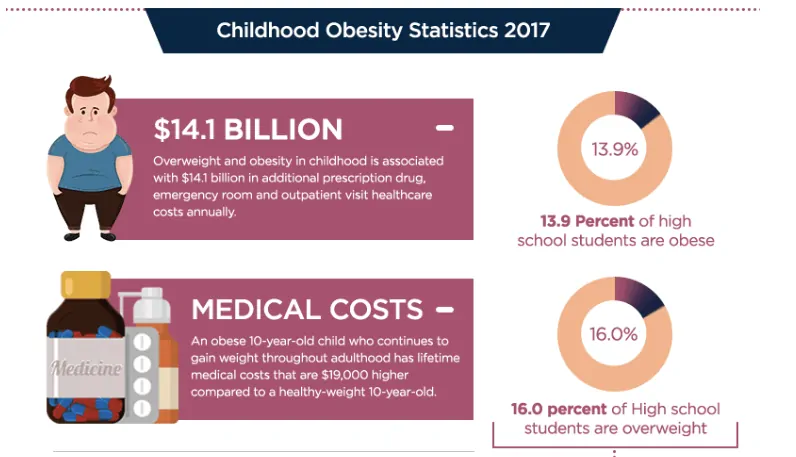Obesity in children has become a source of health concern as significant proportions of children are currently overweight or obese globally. Body mass index (BMI) is a widely used screening tool for measuring both overweight and obesity. BMI percentile is preferred for measuring in children because it takes into account that they are still growing, and growing at different rates depending on their age and sex. Health professionals use growth charts to see whether a child’s weight falls within a healthy range for the child’s height, age, and sex. In children and adolescents age 2 to 19 years, obesity was defined as a body mass index (BMI) at or above the 95th percentile of the sex-specific while Children with a BMI at or above the 85th percentile and less than the 95th percentile are considered overweight (“Obesity Facts | Healthy Schools | CDC,” 2017).
Global burden of childhood obesity
The number of overweight or obese infants and young children (aged 0 to 5 years) increased from 32 million globally in 1990 to 42 million in 2013. In the WHO African Region alone the number of overweight or obese children increased from 4 to 9 million over the same period. If current trends continue the number of overweight or obese infants and young children globally will increase to 70 million by 2025. Without intervention, obese infants and young children will likely continue to be obese during childhood, adolescence, and adulthood (“WHO | Facts, and figures on childhood obesity,” 2014).
Obesity in childhood is associated with a wide range of serious health complications and an increased risk of premature onset of illnesses, including diabetes and heart disease. Exclusive breastfeeding from birth to 6 months of age is an important way to help prevent infants from becoming overweight or obese (“WHO | Facts, and figures on childhood obesity,” 2014).
Childhood obesity in the US
According to Center for Disease Control and Prevention, Childhood Obesity is a serious problem in the United States putting kids at risk for poor health. Despite recent declines in the prevalence among preschool-aged children, obesity amongst all children is still too high. In 2011-2014 For children and adolescents aged 2-19 years:
The prevalence of obesity has remained relatively stable at about 17% and affects about 12.7 million children and adolescents (“Obesity Facts | Healthy Schools | CDC,” 2017).
The prevalence of obesity among children aged 2 to 5 years decreased significantly from 13.9% in 2003-2004 to 9.4% in 2013-2014 (“Obesity Facts | Healthy Schools | CDC,” 2017).
Factors responsible for childhood obesity
In the US, childhood obesity is majorly a problem for the low-income families. From the time of conception to birth and throughout the childhood and adolescent period, many factors contribute to the chances of a child becoming obese.
Gestational diabetes is a known risk factor for increased birth weight in the baby which may predispose the child to development of obesity and its associated comorbidities later in life.
Lack of exclusive breastfeeding (during the first six months after birth) is another risk factor for childhood obesity as well as the development of certain childhood illnesses such as asthma, diarrhea, etc.
Unhealthy diet during infancy and childhood is a significant contributor to the development of obesity in children. Foods containing refined sugars, high-fat contents, and excess calorie intake are all essential ingredients for childhood obesity.
Reduced physical activity due to increased urbanization and digitalization has led to a situation where many children and adolescents are now sedentary in their lifestyle and this has contributed significantly to overweight and obesity among these age groups.
Preventing Childhood Obesity: WHO recommendations
For infants and young children, WHO recommends:
- Early initiation of breastfeeding within one hour of birth;
- Exclusive breastfeeding for the first 6 months of life; and
- The introduction of nutritionally adequate and safe complementary (solid) foods at 6 months together with continued breastfeeding up to two years of age or beyond.
School-aged children and adolescents should:
- Limit energy intake from total fats and sugars;
- Increase consumption of fruit and vegetables, as well as legumes, whole grains, and nuts;
- Engage in regular physical activity (60 minutes a day).
The food industry can play a significant role in reducing childhood obesity by:
- Reducing the fat, sugar and salt content of complementary foods and other processed foods;
- Ensuring that healthy and nutritious choices are available and affordable to all consumers;
- Practicing responsible marketing especially those aimed at children and teenagers
Surgical Option for Obesity
There are increasing news reports of adolescents undergoing bariatric surgery to cure their obesity. Although it’s not a common practice now, there are options children facing insurmountable obesity. Talk to your primary physician today.
References
- Obesity Facts | Healthy Schools | CDC. (2017, January 25). Retrieved from https://www.cdc.gov/healthyschools/obesity/facts.htm
- WHO | Facts and figures on childhood obesity. (2014, October). Retrieved from http://www.who.int/end-childhood-obesity/facts/en/
- Adult Obesity Statistics 2017 – 2030. Retrieved from https://renewbariatrics.com/obesity-statistics/
Obesity Information
Latest Obesity Statistics:





